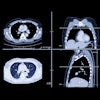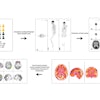CHICAGO - Nuclear medicine vendor SMV this week introduced a novel new scanner that combines CT and PET technologies into a single system. The Twinsburg, OH, company believes that the new system, called Positrace, will improve the detection of cancerous tumors by blending the functional information of PET with the anatomical data collected by CT.
Nuclear medicine vendors have been investigating hybrid scanners for the past several years as a way of improving the diagnostic utility of scintigraphy scans, which are better at providing images of functional processes than of anatomical structure. Both Siemens and GE have developed hybrid units, with the Siemens unit a hybrid CT/PET camera and the GE system an upgrade to a gamma camera.
SMV's Positrace differs, however, in that it represents an attempt by the company to provide clinically diagnostic anatomical information at a price that is affordable for most nuclear medicine departments. SMV plans to sell the system for under $1 million when it becomes commercially available in the second half of 2000, according to Lonnie Mixon, vice president of marketing for the company. Positrace does not have 510(k) clearance and is being shown at the RSNA conference as a work-in-progress.
SMV saved costs in developing the PET side of the scanner by using sodium iodide (NaI) scintillation crystals instead of the more expensive bismuth germanate (BGO), Mixon said. The unit's six detectors are configured in a hexagonal ring about the gantry. For the CT piece of the puzzle, SMV outsourced components from Analogic, which supplies CT parts to a number of other companies. The system employs SMV's PowerStation image processing workstation, which SMV believes is easier to use than the research-oriented workstations found on most PET cameras.
Positrace also features SMV's long-axis detectors, which will enable users to achieve more patient coverage in a single scan than with other PET cameras, according to Mixon. The camera has an axial field-of-view of 500 mm, compared with 250 mm for at least one other camera in the budget PET niche. As a result, Positrace can cover a 78 cm area in just two scans, thus cutting the length of time needed for studies.
Most important, the CT portion of Positrace produces fully diagnostic images, Mixon said, unlike the GE hybrid unit, which is designed to create only reference images. The addition of CT is valuable for applications such as positioning for pre-operative staging or for more accurate quantification for therapeutic evaluations. The CT data can also be used for attenuation correction.
The hybrid CT/PET developed by Siemens also produces diagnostic-quality CT images, but that system is a prototype, based on a high-end CT scanner and a PET camera with BGO detectors. The company has not yet announced whether it will release a commercial model of the unit. SMV believes that in order to become commercially viable, hybrid technology must be both diagnostic and affordable.
"For the technology to be viable broadly, it has to be available for under $1 million," Mixon said. "And it has to have CT to be able to tell anatomically where tumors are."
Positrace will help SMV latch on to the rising PET market, which is growing rapidly due to improved Medicare reimbursement for PET scans. Prior to Positrace, the company did not have a PET system in its product line, other than a coincidence detection upgrade for its gamma camera. The camera should also add to the company's already growing momentum: SMV generated $90 million in revenue in 1998, and the company is on track to produce $100 million in sales in 1999, Mixon said.
By Brian CaseyAuntMinnie.com staff writer
November 29, 1999
















